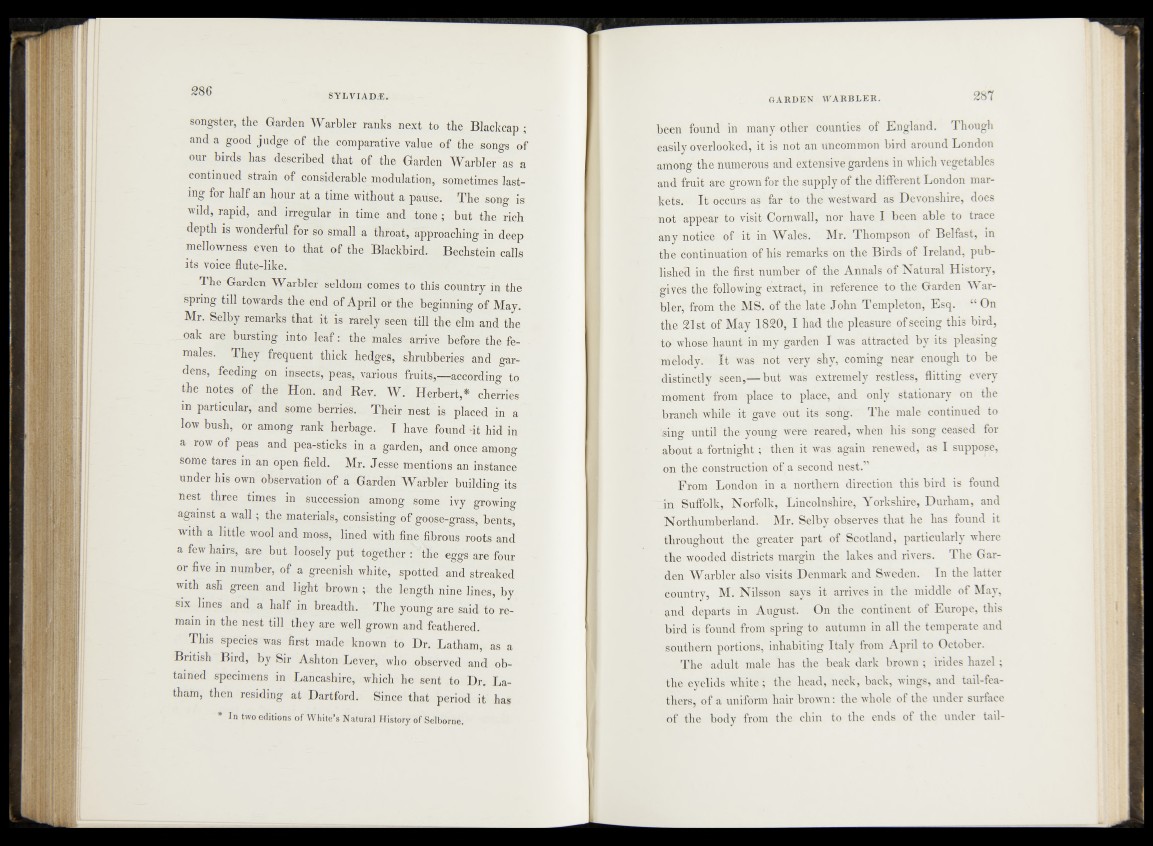
286 SYLVIAD.E.
songster, the Garden Warbler ranks next to the Blackcap ;
and a good judge of the comparative value of the songs of
our birds has described that of the Garden Warbler as a
continued strain of considerable modulation, sometimes lasting
for half an hour at a time without a pause. The song is
wild, rapid, and irregular in time and tone ; but the rich
depth is wonderful for so small a throat, approaching in deep
mellowness even to that of the Blackbird. Bechstein calls
its voice flute-like.
The Garden Warbler seldom comes to this country in the
spring till towards the end of April or the beginning of May.
Mr. Selby remarks that it is rarely seen till the elm and the
oak are bursting into leaf: the males arrive before the females.
They frequent thick hedges, shrubberies and gardens,
feeding on insects, peas, various fruits,—according to
the notes of the Hon. and Rev. W. Herbert,* cherries
in particular, and some berries. Their nest is placed in a
low bush, or among rank herbage. I have found dt hid in
a row of peas and pea-sticks in a garden, and once among
some tares in an open field. Mr. Jesse mentions an instance
under his own observation of a Garden Warbler building its
nest three times in succession among some ivy growing
against a wall; the materials, consisting of goose-grass, bents,
with a little wool and moss, lined with fine fibrous roots and
a few hairs, are but loosely put together : the eggs are four
or five in number, of a greenish white, spotted and streaked
with ash green and light brown ; the length nine lines, by
six lines and a half in breadth. The young are said to remain
in the nest till they are well grown and feathered.
This species was first made known to Dr. Latham, as a
British Bird, by Sir Ashton Lever, who observed and obtained
specimens in Lancashire, which he sent to Dr. Latham,
then residing at Dartford. Since that period it has
* In tw° editions of White’s Natural History of Selborne.
8A R D E N WARBLER. 287
been found in many other counties of England. Though
easily overlooked, it is not an uncommon bird around London
among the numerous and extensive gardens in which vegetables
and fruit are grown for the supply of the different London markets.
It occurs as far to the westward as Devonshire, does
not appear to visit Cornwall, nor have I been able to trace
any notice of it in Wales. Mr. Thompson of Belfast, in
the continuation of his remarks on the Birds of Ireland, published
in the first number of the Annals of Natural History,
gives the following extract, in reference to the Garden Warbler,
from the MS. of the late John Templeton, Esq. “ On
the 21st of May 1820, I had the pleasure of seeing this bird,
to whose haunt in my garden I was attracted by its pleasing
melody. It was not very shy, coming near enough to be
distinctly seen,— but was extremely restless, flitting every
moment from place to place, and only stationary on the
branch while it gave out its song. The male continued to
sing until the young were reared, when his song ceased for
about a fortnight; then it was again renewed, as I suppose,
on the construction of a second nest.”
From London in a northern direction this bird is found
in Suffolk, Norfolk, Lincolnshire, Yorkshire, Durham, and
Northumberland. Mr. Selby observes that he has found it
throughout the greater part of Scotland, particularly where
the wooded districts margin the lakes and rivers. The Garden
Warbler also visits Denmark and Sweden. In the latter
country, M. Nilsson says it arrives in the middle of May,
3,nd departs in August. On the continent of Europe, this
bird is found from spring to autumn in all the temperate and
southern portions, inhabiting Italy from April to October.
The adult male has the beak dark brown ; irides hazel;
the eyelids white; the head, neck, back, wings, and tail-feathers,
of a uniform hair brown: the whole of the under surface
of the body from the chin to the ends of the under tail